Effective Business Communication Report - Tools of Communication
VerifiedAdded on 2020/03/16
|20
|3492
|39
AI Summary
Contribute Materials
Your contribution can guide someone’s learning journey. Share your
documents today.
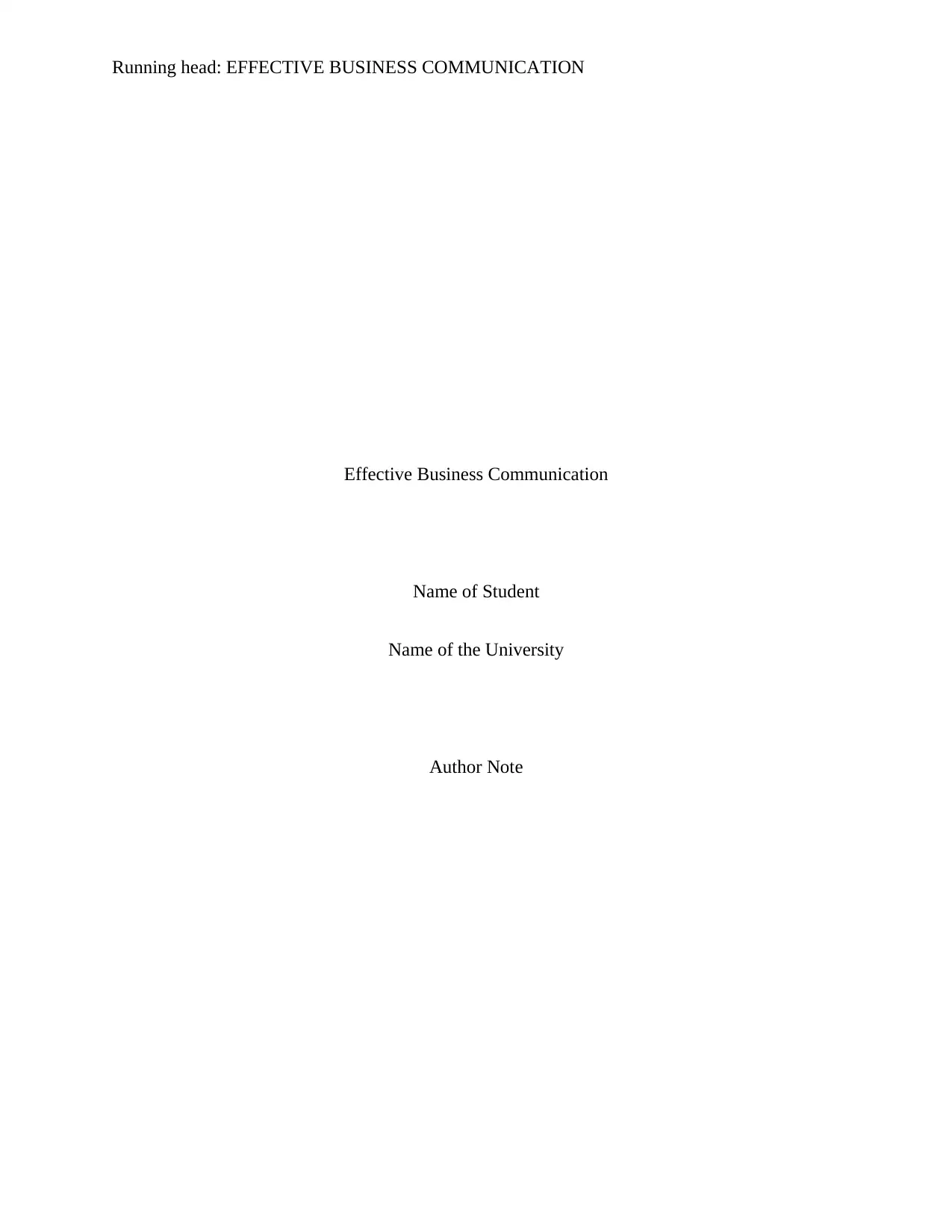
Running head: EFFECTIVE BUSINESS COMMUNICATION
Effective Business Communication
Name of Student
Name of the University
Author Note
Effective Business Communication
Name of Student
Name of the University
Author Note
Secure Best Marks with AI Grader
Need help grading? Try our AI Grader for instant feedback on your assignments.
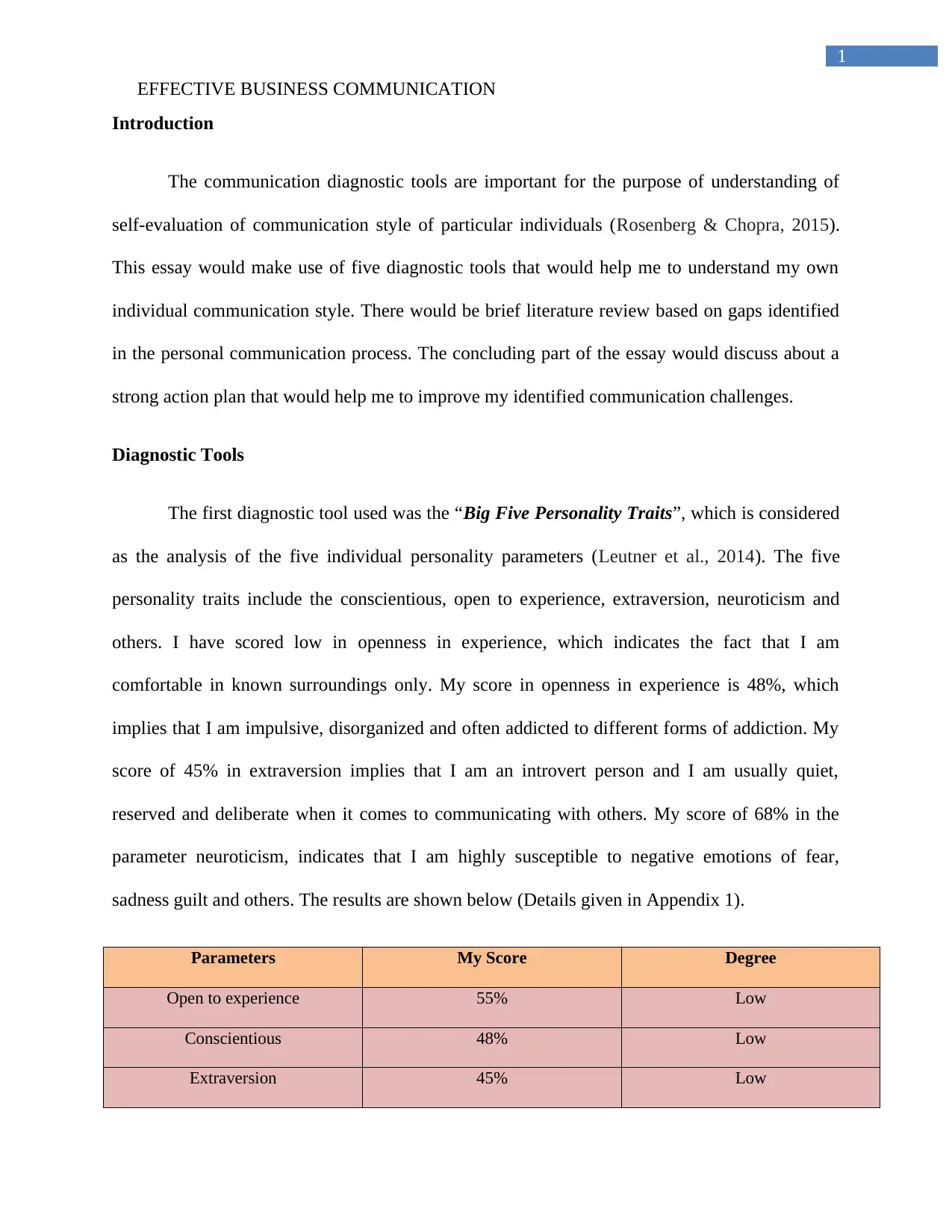
1
EFFECTIVE BUSINESS COMMUNICATION
Introduction
The communication diagnostic tools are important for the purpose of understanding of
self-evaluation of communication style of particular individuals (Rosenberg & Chopra, 2015).
This essay would make use of five diagnostic tools that would help me to understand my own
individual communication style. There would be brief literature review based on gaps identified
in the personal communication process. The concluding part of the essay would discuss about a
strong action plan that would help me to improve my identified communication challenges.
Diagnostic Tools
The first diagnostic tool used was the “Big Five Personality Traits”, which is considered
as the analysis of the five individual personality parameters (Leutner et al., 2014). The five
personality traits include the conscientious, open to experience, extraversion, neuroticism and
others. I have scored low in openness in experience, which indicates the fact that I am
comfortable in known surroundings only. My score in openness in experience is 48%, which
implies that I am impulsive, disorganized and often addicted to different forms of addiction. My
score of 45% in extraversion implies that I am an introvert person and I am usually quiet,
reserved and deliberate when it comes to communicating with others. My score of 68% in the
parameter neuroticism, indicates that I am highly susceptible to negative emotions of fear,
sadness guilt and others. The results are shown below (Details given in Appendix 1).
Parameters My Score Degree
Open to experience 55% Low
Conscientious 48% Low
Extraversion 45% Low
EFFECTIVE BUSINESS COMMUNICATION
Introduction
The communication diagnostic tools are important for the purpose of understanding of
self-evaluation of communication style of particular individuals (Rosenberg & Chopra, 2015).
This essay would make use of five diagnostic tools that would help me to understand my own
individual communication style. There would be brief literature review based on gaps identified
in the personal communication process. The concluding part of the essay would discuss about a
strong action plan that would help me to improve my identified communication challenges.
Diagnostic Tools
The first diagnostic tool used was the “Big Five Personality Traits”, which is considered
as the analysis of the five individual personality parameters (Leutner et al., 2014). The five
personality traits include the conscientious, open to experience, extraversion, neuroticism and
others. I have scored low in openness in experience, which indicates the fact that I am
comfortable in known surroundings only. My score in openness in experience is 48%, which
implies that I am impulsive, disorganized and often addicted to different forms of addiction. My
score of 45% in extraversion implies that I am an introvert person and I am usually quiet,
reserved and deliberate when it comes to communicating with others. My score of 68% in the
parameter neuroticism, indicates that I am highly susceptible to negative emotions of fear,
sadness guilt and others. The results are shown below (Details given in Appendix 1).
Parameters My Score Degree
Open to experience 55% Low
Conscientious 48% Low
Extraversion 45% Low
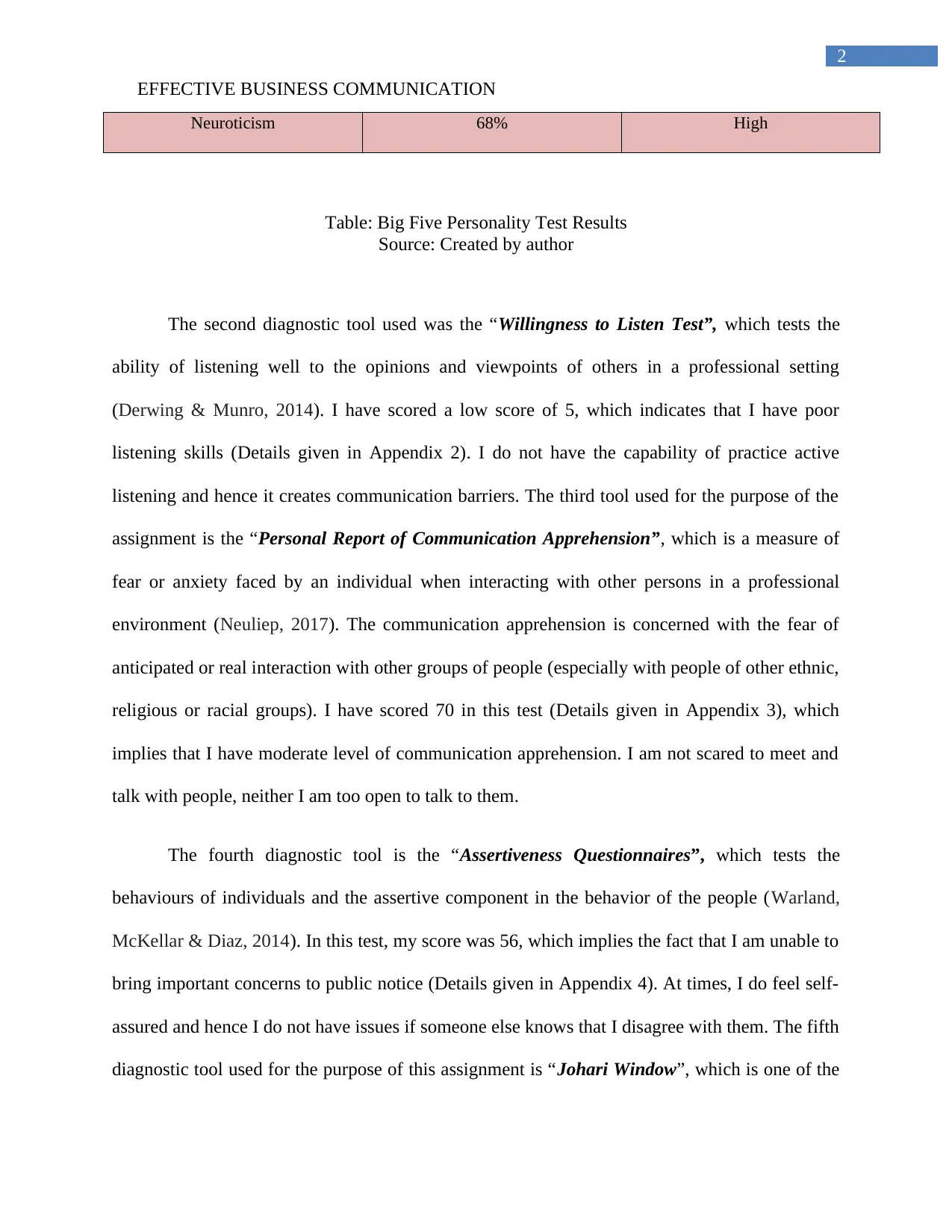
2
EFFECTIVE BUSINESS COMMUNICATION
Neuroticism 68% High
Table: Big Five Personality Test Results
Source: Created by author
The second diagnostic tool used was the “Willingness to Listen Test”, which tests the
ability of listening well to the opinions and viewpoints of others in a professional setting
(Derwing & Munro, 2014). I have scored a low score of 5, which indicates that I have poor
listening skills (Details given in Appendix 2). I do not have the capability of practice active
listening and hence it creates communication barriers. The third tool used for the purpose of the
assignment is the “Personal Report of Communication Apprehension”, which is a measure of
fear or anxiety faced by an individual when interacting with other persons in a professional
environment (Neuliep, 2017). The communication apprehension is concerned with the fear of
anticipated or real interaction with other groups of people (especially with people of other ethnic,
religious or racial groups). I have scored 70 in this test (Details given in Appendix 3), which
implies that I have moderate level of communication apprehension. I am not scared to meet and
talk with people, neither I am too open to talk to them.
The fourth diagnostic tool is the “Assertiveness Questionnaires”, which tests the
behaviours of individuals and the assertive component in the behavior of the people (Warland,
McKellar & Diaz, 2014). In this test, my score was 56, which implies the fact that I am unable to
bring important concerns to public notice (Details given in Appendix 4). At times, I do feel self-
assured and hence I do not have issues if someone else knows that I disagree with them. The fifth
diagnostic tool used for the purpose of this assignment is “Johari Window”, which is one of the
EFFECTIVE BUSINESS COMMUNICATION
Neuroticism 68% High
Table: Big Five Personality Test Results
Source: Created by author
The second diagnostic tool used was the “Willingness to Listen Test”, which tests the
ability of listening well to the opinions and viewpoints of others in a professional setting
(Derwing & Munro, 2014). I have scored a low score of 5, which indicates that I have poor
listening skills (Details given in Appendix 2). I do not have the capability of practice active
listening and hence it creates communication barriers. The third tool used for the purpose of the
assignment is the “Personal Report of Communication Apprehension”, which is a measure of
fear or anxiety faced by an individual when interacting with other persons in a professional
environment (Neuliep, 2017). The communication apprehension is concerned with the fear of
anticipated or real interaction with other groups of people (especially with people of other ethnic,
religious or racial groups). I have scored 70 in this test (Details given in Appendix 3), which
implies that I have moderate level of communication apprehension. I am not scared to meet and
talk with people, neither I am too open to talk to them.
The fourth diagnostic tool is the “Assertiveness Questionnaires”, which tests the
behaviours of individuals and the assertive component in the behavior of the people (Warland,
McKellar & Diaz, 2014). In this test, my score was 56, which implies the fact that I am unable to
bring important concerns to public notice (Details given in Appendix 4). At times, I do feel self-
assured and hence I do not have issues if someone else knows that I disagree with them. The fifth
diagnostic tool used for the purpose of this assignment is “Johari Window”, which is one of the
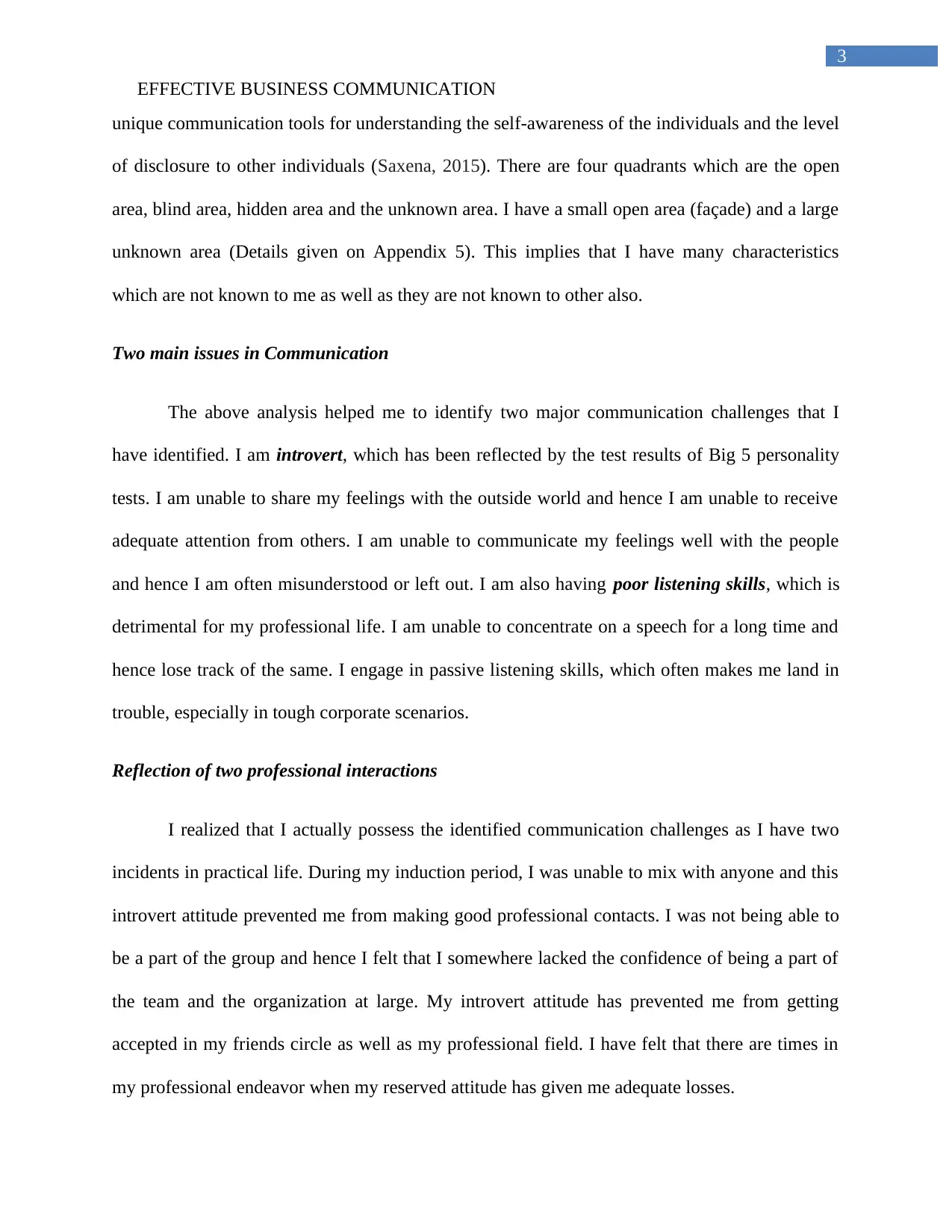
3
EFFECTIVE BUSINESS COMMUNICATION
unique communication tools for understanding the self-awareness of the individuals and the level
of disclosure to other individuals (Saxena, 2015). There are four quadrants which are the open
area, blind area, hidden area and the unknown area. I have a small open area (façade) and a large
unknown area (Details given on Appendix 5). This implies that I have many characteristics
which are not known to me as well as they are not known to other also.
Two main issues in Communication
The above analysis helped me to identify two major communication challenges that I
have identified. I am introvert, which has been reflected by the test results of Big 5 personality
tests. I am unable to share my feelings with the outside world and hence I am unable to receive
adequate attention from others. I am unable to communicate my feelings well with the people
and hence I am often misunderstood or left out. I am also having poor listening skills, which is
detrimental for my professional life. I am unable to concentrate on a speech for a long time and
hence lose track of the same. I engage in passive listening skills, which often makes me land in
trouble, especially in tough corporate scenarios.
Reflection of two professional interactions
I realized that I actually possess the identified communication challenges as I have two
incidents in practical life. During my induction period, I was unable to mix with anyone and this
introvert attitude prevented me from making good professional contacts. I was not being able to
be a part of the group and hence I felt that I somewhere lacked the confidence of being a part of
the team and the organization at large. My introvert attitude has prevented me from getting
accepted in my friends circle as well as my professional field. I have felt that there are times in
my professional endeavor when my reserved attitude has given me adequate losses.
EFFECTIVE BUSINESS COMMUNICATION
unique communication tools for understanding the self-awareness of the individuals and the level
of disclosure to other individuals (Saxena, 2015). There are four quadrants which are the open
area, blind area, hidden area and the unknown area. I have a small open area (façade) and a large
unknown area (Details given on Appendix 5). This implies that I have many characteristics
which are not known to me as well as they are not known to other also.
Two main issues in Communication
The above analysis helped me to identify two major communication challenges that I
have identified. I am introvert, which has been reflected by the test results of Big 5 personality
tests. I am unable to share my feelings with the outside world and hence I am unable to receive
adequate attention from others. I am unable to communicate my feelings well with the people
and hence I am often misunderstood or left out. I am also having poor listening skills, which is
detrimental for my professional life. I am unable to concentrate on a speech for a long time and
hence lose track of the same. I engage in passive listening skills, which often makes me land in
trouble, especially in tough corporate scenarios.
Reflection of two professional interactions
I realized that I actually possess the identified communication challenges as I have two
incidents in practical life. During my induction period, I was unable to mix with anyone and this
introvert attitude prevented me from making good professional contacts. I was not being able to
be a part of the group and hence I felt that I somewhere lacked the confidence of being a part of
the team and the organization at large. My introvert attitude has prevented me from getting
accepted in my friends circle as well as my professional field. I have felt that there are times in
my professional endeavor when my reserved attitude has given me adequate losses.
Secure Best Marks with AI Grader
Need help grading? Try our AI Grader for instant feedback on your assignments.

4
EFFECTIVE BUSINESS COMMUNICATION
When I was sent to an on-site task, I had one meeting in the client office. I was engaging
in a one-to one discussion with my client, when I started distracting myself and slowly my
thoughts engulfed my mind. I found it difficult to keep track of the conversation and this was
well understood by my client. I was embarrassed by my behavior and I asked some stupid
questions, the answers of which was already shared by the client. I repented my actions and this
incident gave me negative impression. After this incident, I was determined that I need to
overcome my communication challenges so that it might not endanger my future professional
meetings.
Literature Review
As opined by Zelenski, Sobocko and Whelan (2014), the “introversion” is concerned
with the chronic under stimulation of the individuals in which there is reduced social activity and
there is lack of social circle. The introvert individuals are characterized by their timid, reserved
and quiet approach in which there is lesser interaction with other members of the society. One of
the most important features of the introvert individuals is that they have increased instances of
solitude (Zelenski, Sobocko & Whelan 2014). They tend to spend more time on activities in
which there is least interaction with the other people. They are often apprehensive about
interacting with other people and they wish to seek their own company. These types of
individuals have less interaction with the outside society and they tend to create their own small
world. However, McIntyre, Wiener and Saliba (2015) argued that the introverts are happier in
certain culture which does not display individualistic characteristics. This is because of the fact
in such cultures; the society does not expect them to act in a manner, which is displayed by the
extraverts (Malik & Zamir, 2014). This makes the individuals who are introverts to behave in a
particular manner, in which they feel most comfortable.
EFFECTIVE BUSINESS COMMUNICATION
When I was sent to an on-site task, I had one meeting in the client office. I was engaging
in a one-to one discussion with my client, when I started distracting myself and slowly my
thoughts engulfed my mind. I found it difficult to keep track of the conversation and this was
well understood by my client. I was embarrassed by my behavior and I asked some stupid
questions, the answers of which was already shared by the client. I repented my actions and this
incident gave me negative impression. After this incident, I was determined that I need to
overcome my communication challenges so that it might not endanger my future professional
meetings.
Literature Review
As opined by Zelenski, Sobocko and Whelan (2014), the “introversion” is concerned
with the chronic under stimulation of the individuals in which there is reduced social activity and
there is lack of social circle. The introvert individuals are characterized by their timid, reserved
and quiet approach in which there is lesser interaction with other members of the society. One of
the most important features of the introvert individuals is that they have increased instances of
solitude (Zelenski, Sobocko & Whelan 2014). They tend to spend more time on activities in
which there is least interaction with the other people. They are often apprehensive about
interacting with other people and they wish to seek their own company. These types of
individuals have less interaction with the outside society and they tend to create their own small
world. However, McIntyre, Wiener and Saliba (2015) argued that the introverts are happier in
certain culture which does not display individualistic characteristics. This is because of the fact
in such cultures; the society does not expect them to act in a manner, which is displayed by the
extraverts (Malik & Zamir, 2014). This makes the individuals who are introverts to behave in a
particular manner, in which they feel most comfortable.
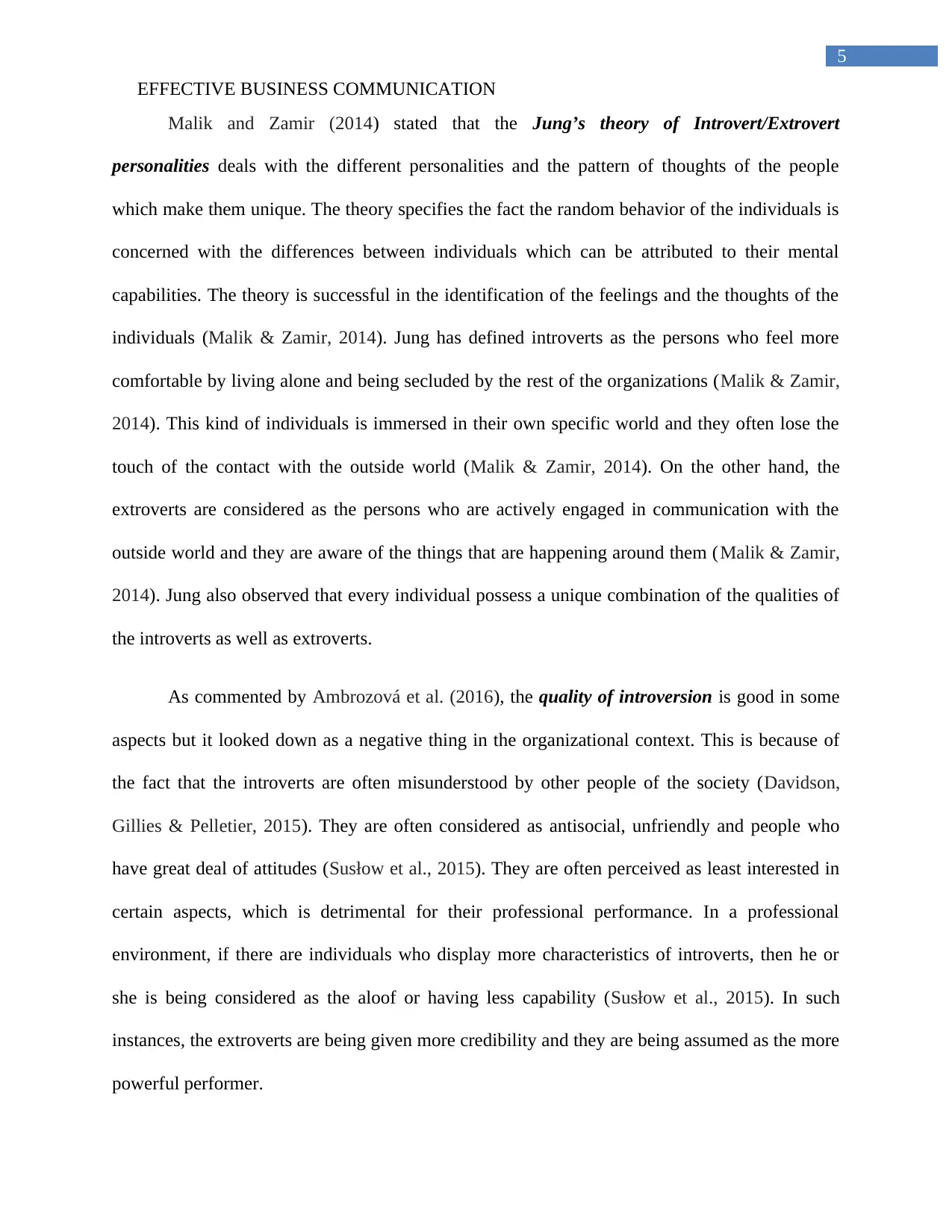
5
EFFECTIVE BUSINESS COMMUNICATION
Malik and Zamir (2014) stated that the Jung’s theory of Introvert/Extrovert
personalities deals with the different personalities and the pattern of thoughts of the people
which make them unique. The theory specifies the fact the random behavior of the individuals is
concerned with the differences between individuals which can be attributed to their mental
capabilities. The theory is successful in the identification of the feelings and the thoughts of the
individuals (Malik & Zamir, 2014). Jung has defined introverts as the persons who feel more
comfortable by living alone and being secluded by the rest of the organizations (Malik & Zamir,
2014). This kind of individuals is immersed in their own specific world and they often lose the
touch of the contact with the outside world (Malik & Zamir, 2014). On the other hand, the
extroverts are considered as the persons who are actively engaged in communication with the
outside world and they are aware of the things that are happening around them (Malik & Zamir,
2014). Jung also observed that every individual possess a unique combination of the qualities of
the introverts as well as extroverts.
As commented by Ambrozová et al. (2016), the quality of introversion is good in some
aspects but it looked down as a negative thing in the organizational context. This is because of
the fact that the introverts are often misunderstood by other people of the society (Davidson,
Gillies & Pelletier, 2015). They are often considered as antisocial, unfriendly and people who
have great deal of attitudes (Susłow et al., 2015). They are often perceived as least interested in
certain aspects, which is detrimental for their professional performance. In a professional
environment, if there are individuals who display more characteristics of introverts, then he or
she is being considered as the aloof or having less capability (Susłow et al., 2015). In such
instances, the extroverts are being given more credibility and they are being assumed as the more
powerful performer.
EFFECTIVE BUSINESS COMMUNICATION
Malik and Zamir (2014) stated that the Jung’s theory of Introvert/Extrovert
personalities deals with the different personalities and the pattern of thoughts of the people
which make them unique. The theory specifies the fact the random behavior of the individuals is
concerned with the differences between individuals which can be attributed to their mental
capabilities. The theory is successful in the identification of the feelings and the thoughts of the
individuals (Malik & Zamir, 2014). Jung has defined introverts as the persons who feel more
comfortable by living alone and being secluded by the rest of the organizations (Malik & Zamir,
2014). This kind of individuals is immersed in their own specific world and they often lose the
touch of the contact with the outside world (Malik & Zamir, 2014). On the other hand, the
extroverts are considered as the persons who are actively engaged in communication with the
outside world and they are aware of the things that are happening around them (Malik & Zamir,
2014). Jung also observed that every individual possess a unique combination of the qualities of
the introverts as well as extroverts.
As commented by Ambrozová et al. (2016), the quality of introversion is good in some
aspects but it looked down as a negative thing in the organizational context. This is because of
the fact that the introverts are often misunderstood by other people of the society (Davidson,
Gillies & Pelletier, 2015). They are often considered as antisocial, unfriendly and people who
have great deal of attitudes (Susłow et al., 2015). They are often perceived as least interested in
certain aspects, which is detrimental for their professional performance. In a professional
environment, if there are individuals who display more characteristics of introverts, then he or
she is being considered as the aloof or having less capability (Susłow et al., 2015). In such
instances, the extroverts are being given more credibility and they are being assumed as the more
powerful performer.
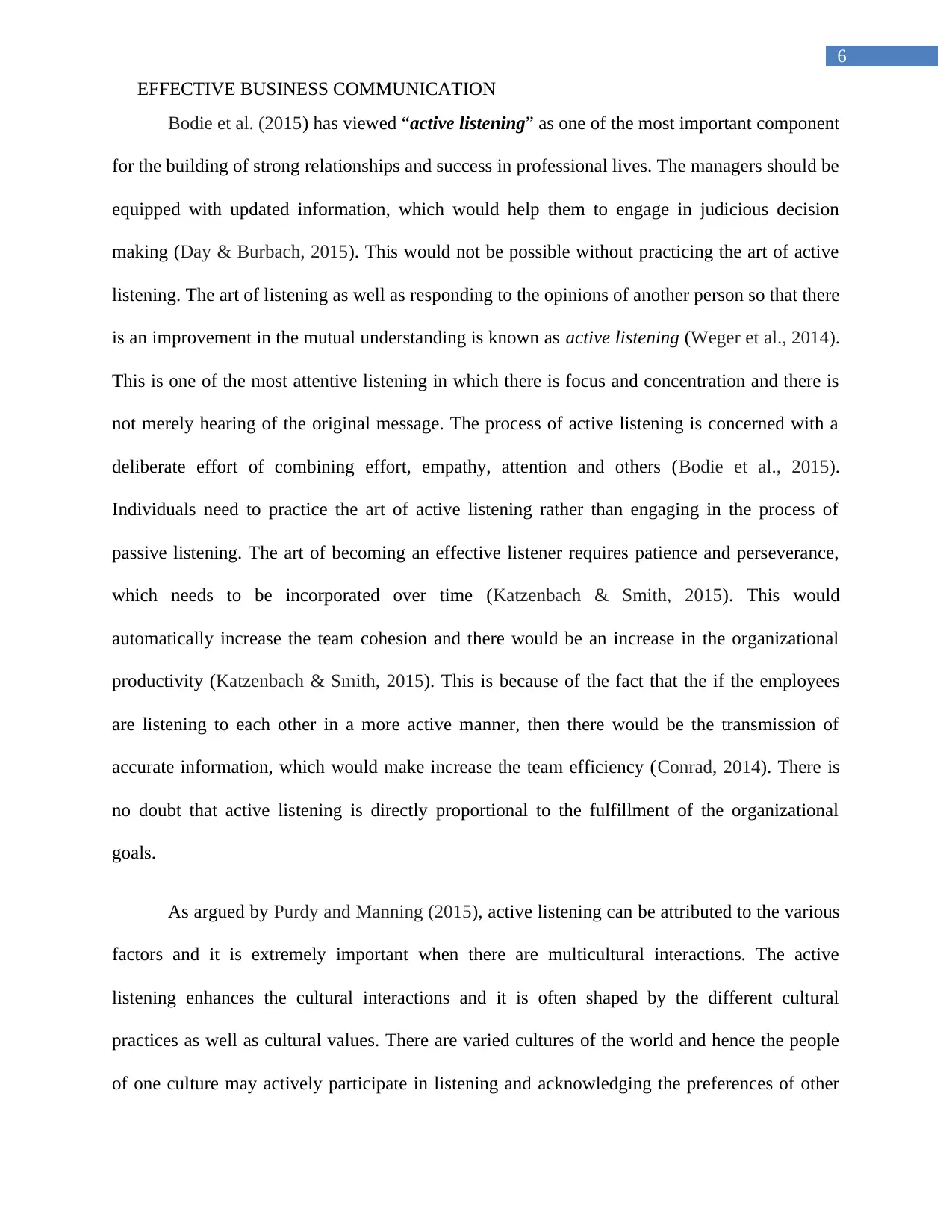
6
EFFECTIVE BUSINESS COMMUNICATION
Bodie et al. (2015) has viewed “active listening” as one of the most important component
for the building of strong relationships and success in professional lives. The managers should be
equipped with updated information, which would help them to engage in judicious decision
making (Day & Burbach, 2015). This would not be possible without practicing the art of active
listening. The art of listening as well as responding to the opinions of another person so that there
is an improvement in the mutual understanding is known as active listening (Weger et al., 2014).
This is one of the most attentive listening in which there is focus and concentration and there is
not merely hearing of the original message. The process of active listening is concerned with a
deliberate effort of combining effort, empathy, attention and others (Bodie et al., 2015).
Individuals need to practice the art of active listening rather than engaging in the process of
passive listening. The art of becoming an effective listener requires patience and perseverance,
which needs to be incorporated over time (Katzenbach & Smith, 2015). This would
automatically increase the team cohesion and there would be an increase in the organizational
productivity (Katzenbach & Smith, 2015). This is because of the fact that the if the employees
are listening to each other in a more active manner, then there would be the transmission of
accurate information, which would make increase the team efficiency (Conrad, 2014). There is
no doubt that active listening is directly proportional to the fulfillment of the organizational
goals.
As argued by Purdy and Manning (2015), active listening can be attributed to the various
factors and it is extremely important when there are multicultural interactions. The active
listening enhances the cultural interactions and it is often shaped by the different cultural
practices as well as cultural values. There are varied cultures of the world and hence the people
of one culture may actively participate in listening and acknowledging the preferences of other
EFFECTIVE BUSINESS COMMUNICATION
Bodie et al. (2015) has viewed “active listening” as one of the most important component
for the building of strong relationships and success in professional lives. The managers should be
equipped with updated information, which would help them to engage in judicious decision
making (Day & Burbach, 2015). This would not be possible without practicing the art of active
listening. The art of listening as well as responding to the opinions of another person so that there
is an improvement in the mutual understanding is known as active listening (Weger et al., 2014).
This is one of the most attentive listening in which there is focus and concentration and there is
not merely hearing of the original message. The process of active listening is concerned with a
deliberate effort of combining effort, empathy, attention and others (Bodie et al., 2015).
Individuals need to practice the art of active listening rather than engaging in the process of
passive listening. The art of becoming an effective listener requires patience and perseverance,
which needs to be incorporated over time (Katzenbach & Smith, 2015). This would
automatically increase the team cohesion and there would be an increase in the organizational
productivity (Katzenbach & Smith, 2015). This is because of the fact that the if the employees
are listening to each other in a more active manner, then there would be the transmission of
accurate information, which would make increase the team efficiency (Conrad, 2014). There is
no doubt that active listening is directly proportional to the fulfillment of the organizational
goals.
As argued by Purdy and Manning (2015), active listening can be attributed to the various
factors and it is extremely important when there are multicultural interactions. The active
listening enhances the cultural interactions and it is often shaped by the different cultural
practices as well as cultural values. There are varied cultures of the world and hence the people
of one culture may actively participate in listening and acknowledging the preferences of other
Paraphrase This Document
Need a fresh take? Get an instant paraphrase of this document with our AI Paraphraser
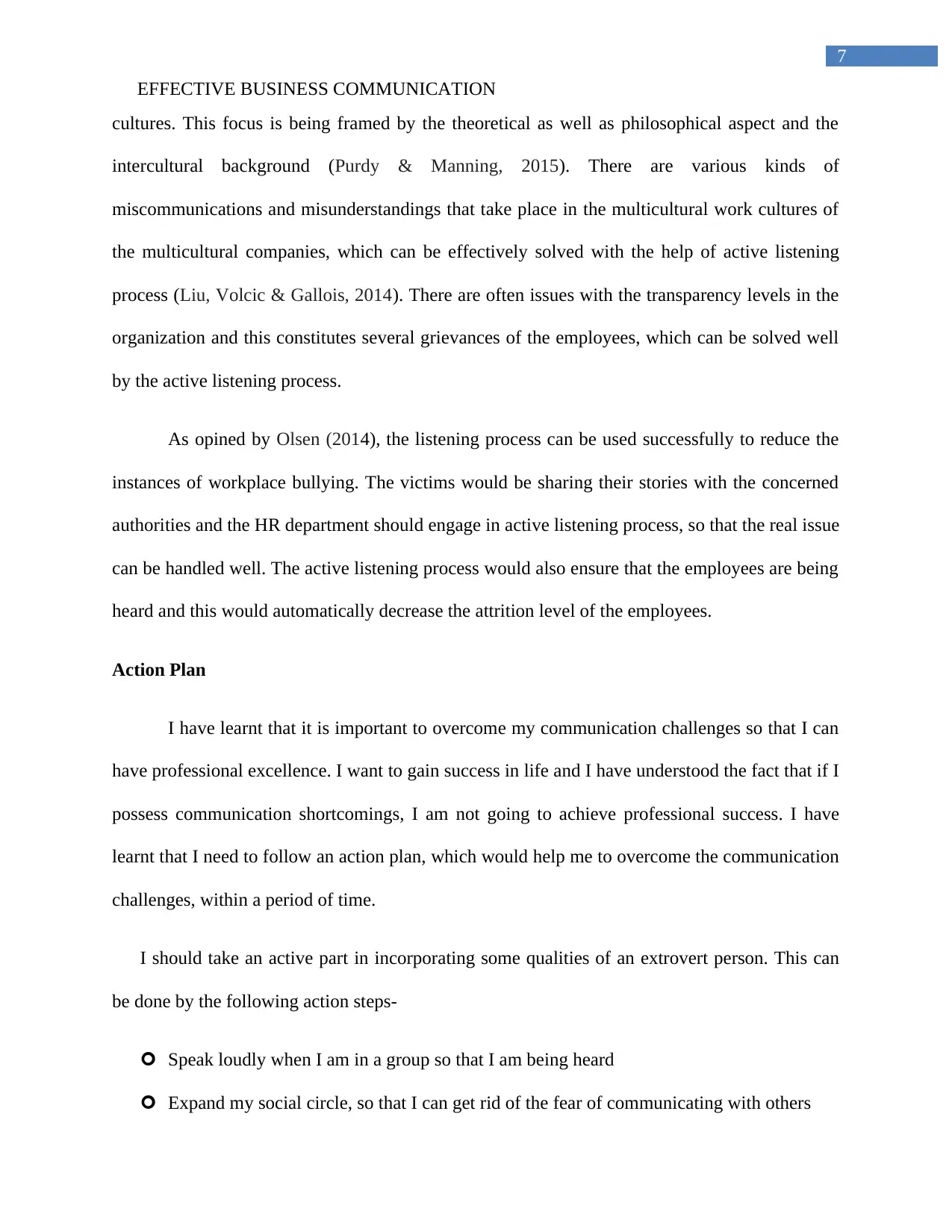
7
EFFECTIVE BUSINESS COMMUNICATION
cultures. This focus is being framed by the theoretical as well as philosophical aspect and the
intercultural background (Purdy & Manning, 2015). There are various kinds of
miscommunications and misunderstandings that take place in the multicultural work cultures of
the multicultural companies, which can be effectively solved with the help of active listening
process (Liu, Volcic & Gallois, 2014). There are often issues with the transparency levels in the
organization and this constitutes several grievances of the employees, which can be solved well
by the active listening process.
As opined by Olsen (2014), the listening process can be used successfully to reduce the
instances of workplace bullying. The victims would be sharing their stories with the concerned
authorities and the HR department should engage in active listening process, so that the real issue
can be handled well. The active listening process would also ensure that the employees are being
heard and this would automatically decrease the attrition level of the employees.
Action Plan
I have learnt that it is important to overcome my communication challenges so that I can
have professional excellence. I want to gain success in life and I have understood the fact that if I
possess communication shortcomings, I am not going to achieve professional success. I have
learnt that I need to follow an action plan, which would help me to overcome the communication
challenges, within a period of time.
I should take an active part in incorporating some qualities of an extrovert person. This can
be done by the following action steps-
Speak loudly when I am in a group so that I am being heard
Expand my social circle, so that I can get rid of the fear of communicating with others
EFFECTIVE BUSINESS COMMUNICATION
cultures. This focus is being framed by the theoretical as well as philosophical aspect and the
intercultural background (Purdy & Manning, 2015). There are various kinds of
miscommunications and misunderstandings that take place in the multicultural work cultures of
the multicultural companies, which can be effectively solved with the help of active listening
process (Liu, Volcic & Gallois, 2014). There are often issues with the transparency levels in the
organization and this constitutes several grievances of the employees, which can be solved well
by the active listening process.
As opined by Olsen (2014), the listening process can be used successfully to reduce the
instances of workplace bullying. The victims would be sharing their stories with the concerned
authorities and the HR department should engage in active listening process, so that the real issue
can be handled well. The active listening process would also ensure that the employees are being
heard and this would automatically decrease the attrition level of the employees.
Action Plan
I have learnt that it is important to overcome my communication challenges so that I can
have professional excellence. I want to gain success in life and I have understood the fact that if I
possess communication shortcomings, I am not going to achieve professional success. I have
learnt that I need to follow an action plan, which would help me to overcome the communication
challenges, within a period of time.
I should take an active part in incorporating some qualities of an extrovert person. This can
be done by the following action steps-
Speak loudly when I am in a group so that I am being heard
Expand my social circle, so that I can get rid of the fear of communicating with others
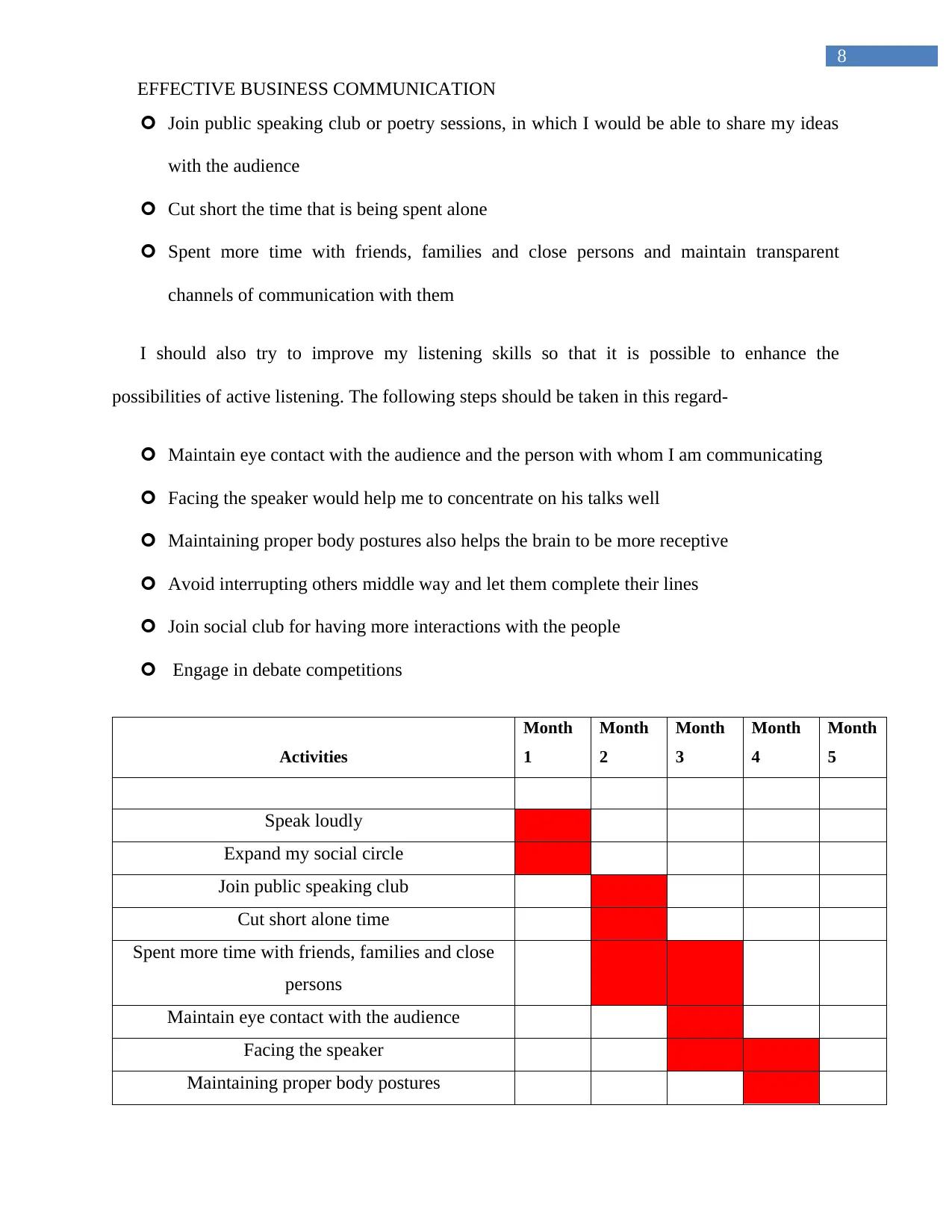
8
EFFECTIVE BUSINESS COMMUNICATION
Join public speaking club or poetry sessions, in which I would be able to share my ideas
with the audience
Cut short the time that is being spent alone
Spent more time with friends, families and close persons and maintain transparent
channels of communication with them
I should also try to improve my listening skills so that it is possible to enhance the
possibilities of active listening. The following steps should be taken in this regard-
Maintain eye contact with the audience and the person with whom I am communicating
Facing the speaker would help me to concentrate on his talks well
Maintaining proper body postures also helps the brain to be more receptive
Avoid interrupting others middle way and let them complete their lines
Join social club for having more interactions with the people
Engage in debate competitions
Activities
Month
1
Month
2
Month
3
Month
4
Month
5
Speak loudly
Expand my social circle
Join public speaking club
Cut short alone time
Spent more time with friends, families and close
persons
Maintain eye contact with the audience
Facing the speaker
Maintaining proper body postures
EFFECTIVE BUSINESS COMMUNICATION
Join public speaking club or poetry sessions, in which I would be able to share my ideas
with the audience
Cut short the time that is being spent alone
Spent more time with friends, families and close persons and maintain transparent
channels of communication with them
I should also try to improve my listening skills so that it is possible to enhance the
possibilities of active listening. The following steps should be taken in this regard-
Maintain eye contact with the audience and the person with whom I am communicating
Facing the speaker would help me to concentrate on his talks well
Maintaining proper body postures also helps the brain to be more receptive
Avoid interrupting others middle way and let them complete their lines
Join social club for having more interactions with the people
Engage in debate competitions
Activities
Month
1
Month
2
Month
3
Month
4
Month
5
Speak loudly
Expand my social circle
Join public speaking club
Cut short alone time
Spent more time with friends, families and close
persons
Maintain eye contact with the audience
Facing the speaker
Maintaining proper body postures
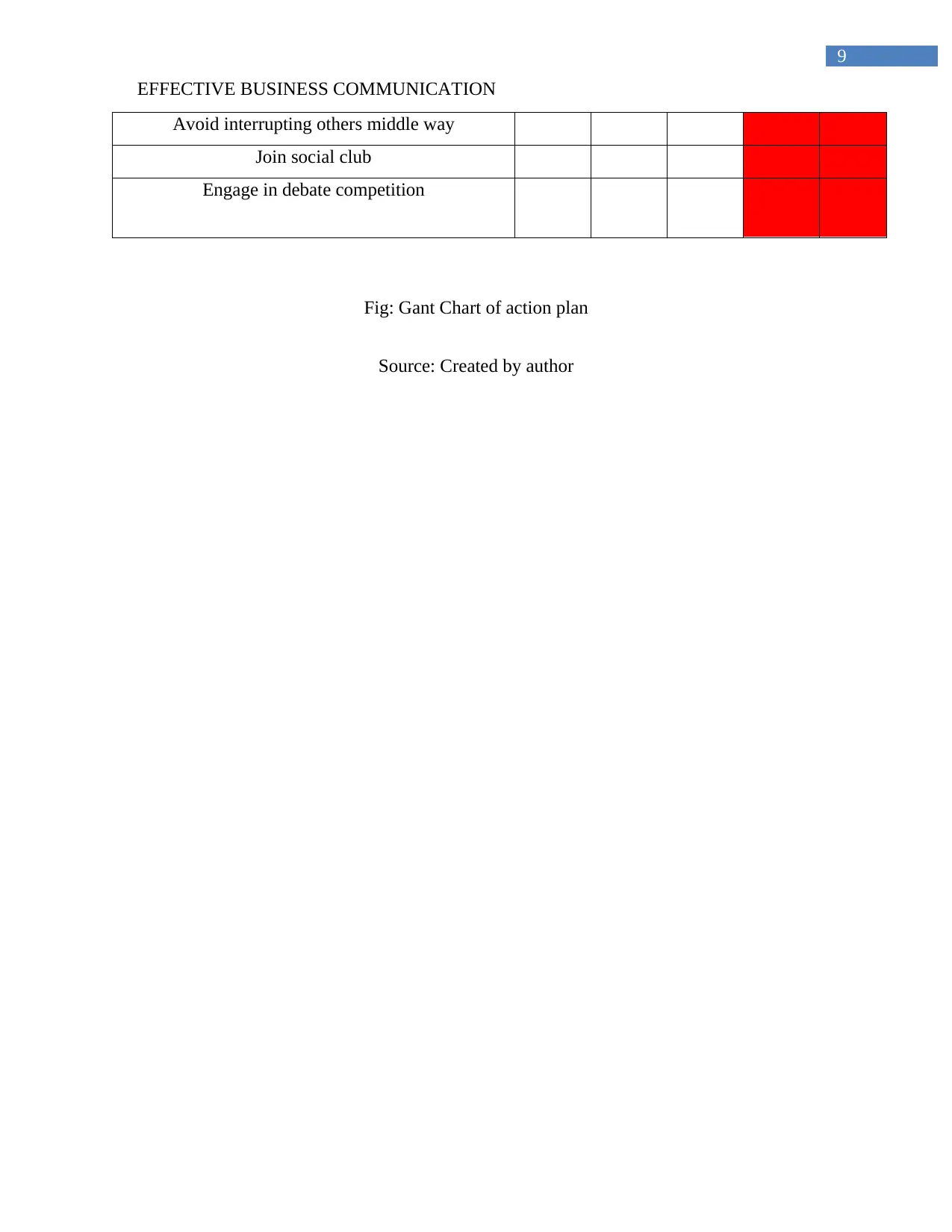
9
EFFECTIVE BUSINESS COMMUNICATION
Avoid interrupting others middle way
Join social club
Engage in debate competition
Fig: Gant Chart of action plan
Source: Created by author
EFFECTIVE BUSINESS COMMUNICATION
Avoid interrupting others middle way
Join social club
Engage in debate competition
Fig: Gant Chart of action plan
Source: Created by author
Secure Best Marks with AI Grader
Need help grading? Try our AI Grader for instant feedback on your assignments.

10
EFFECTIVE BUSINESS COMMUNICATION
References
Ambrozová, E., Koleňák, J., Ullrich, D., & Pokorný, V. (2016). Effectiveness of competent
decision making of professional managers in the context of the modern corporate
environment and its requirements for the quality of their skills. In of the 9th International
Conference (p. 6).
Bodie, G. D., Vickery, A. J., Cannava, K., & Jones, S. M. (2015). The role of “active listening”
in informal helping conversations: Impact on perceptions of listener helpfulness,
sensitivity, and supportiveness and discloser emotional improvement. Western Journal of
Communication, 79(2), 151-173.
Conrad, D. (2014). Workplace communication problems: Inquiries by employees and applicable
solutions. Journal of business studies quarterly, 5(4), 105.
Davidson, B., Gillies, R. A., & Pelletier, A. L. (2015). Introversion and medical student
education: Challenges for both students and educators. Teaching and learning in
medicine, 27(1), 99-104.
Day, F. C., & Burbach, M. E. (2015). Does organization sector matter in leading teleworker
teams? A comparative case study. International Journal of Business Research and
Development, 3(4).
Derwing, T. M., & Munro, M. J. (2014). 10 Training Native Speakers to Listen to L2
Speech. Social dynamics in second language accent, 10, 219.
Katzenbach, J. R., & Smith, D. K. (2015). The wisdom of teams: Creating the high-performance
organization. Harvard Business Review Press.
EFFECTIVE BUSINESS COMMUNICATION
References
Ambrozová, E., Koleňák, J., Ullrich, D., & Pokorný, V. (2016). Effectiveness of competent
decision making of professional managers in the context of the modern corporate
environment and its requirements for the quality of their skills. In of the 9th International
Conference (p. 6).
Bodie, G. D., Vickery, A. J., Cannava, K., & Jones, S. M. (2015). The role of “active listening”
in informal helping conversations: Impact on perceptions of listener helpfulness,
sensitivity, and supportiveness and discloser emotional improvement. Western Journal of
Communication, 79(2), 151-173.
Conrad, D. (2014). Workplace communication problems: Inquiries by employees and applicable
solutions. Journal of business studies quarterly, 5(4), 105.
Davidson, B., Gillies, R. A., & Pelletier, A. L. (2015). Introversion and medical student
education: Challenges for both students and educators. Teaching and learning in
medicine, 27(1), 99-104.
Day, F. C., & Burbach, M. E. (2015). Does organization sector matter in leading teleworker
teams? A comparative case study. International Journal of Business Research and
Development, 3(4).
Derwing, T. M., & Munro, M. J. (2014). 10 Training Native Speakers to Listen to L2
Speech. Social dynamics in second language accent, 10, 219.
Katzenbach, J. R., & Smith, D. K. (2015). The wisdom of teams: Creating the high-performance
organization. Harvard Business Review Press.
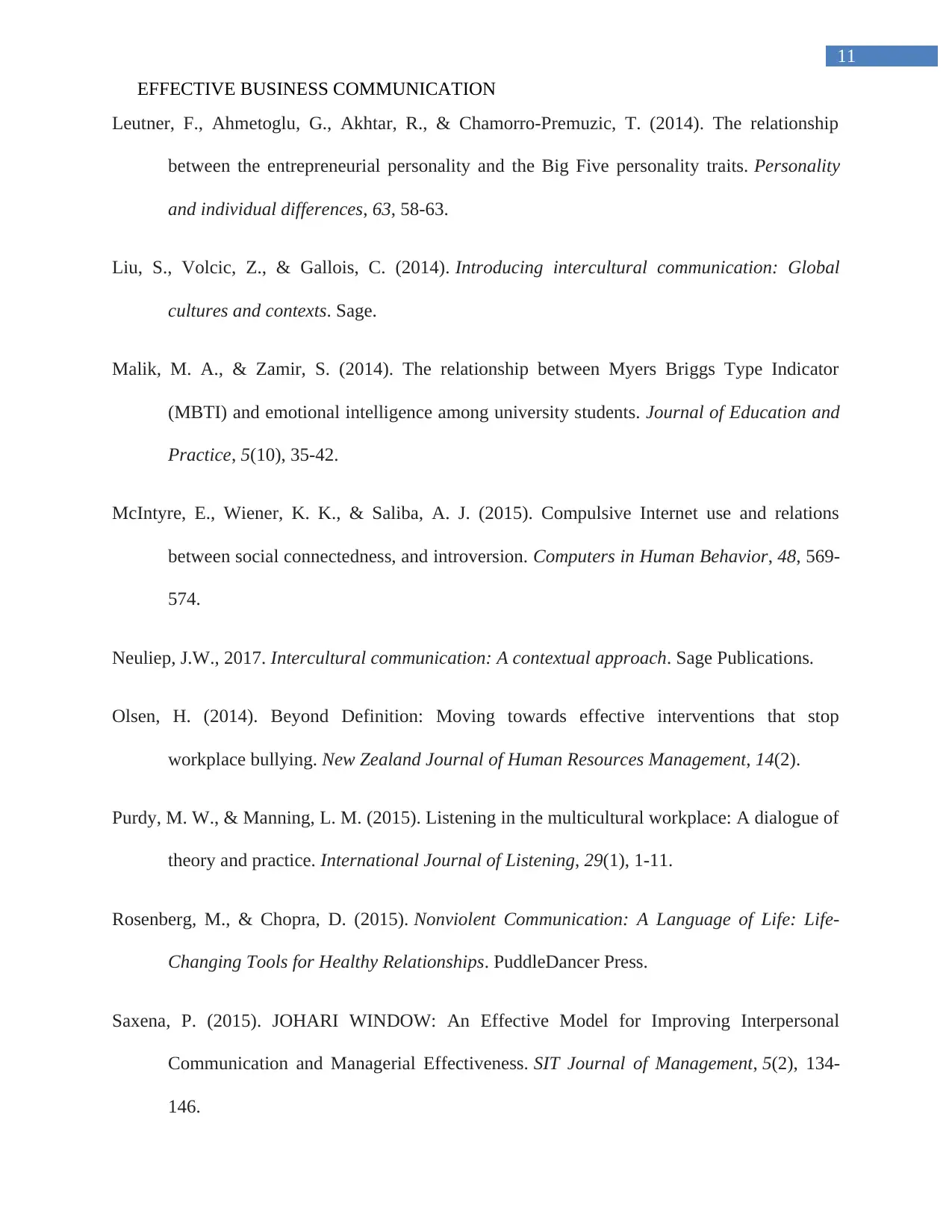
11
EFFECTIVE BUSINESS COMMUNICATION
Leutner, F., Ahmetoglu, G., Akhtar, R., & Chamorro-Premuzic, T. (2014). The relationship
between the entrepreneurial personality and the Big Five personality traits. Personality
and individual differences, 63, 58-63.
Liu, S., Volcic, Z., & Gallois, C. (2014). Introducing intercultural communication: Global
cultures and contexts. Sage.
Malik, M. A., & Zamir, S. (2014). The relationship between Myers Briggs Type Indicator
(MBTI) and emotional intelligence among university students. Journal of Education and
Practice, 5(10), 35-42.
McIntyre, E., Wiener, K. K., & Saliba, A. J. (2015). Compulsive Internet use and relations
between social connectedness, and introversion. Computers in Human Behavior, 48, 569-
574.
Neuliep, J.W., 2017. Intercultural communication: A contextual approach. Sage Publications.
Olsen, H. (2014). Beyond Definition: Moving towards effective interventions that stop
workplace bullying. New Zealand Journal of Human Resources Management, 14(2).
Purdy, M. W., & Manning, L. M. (2015). Listening in the multicultural workplace: A dialogue of
theory and practice. International Journal of Listening, 29(1), 1-11.
Rosenberg, M., & Chopra, D. (2015). Nonviolent Communication: A Language of Life: Life-
Changing Tools for Healthy Relationships. PuddleDancer Press.
Saxena, P. (2015). JOHARI WINDOW: An Effective Model for Improving Interpersonal
Communication and Managerial Effectiveness. SIT Journal of Management, 5(2), 134-
146.
EFFECTIVE BUSINESS COMMUNICATION
Leutner, F., Ahmetoglu, G., Akhtar, R., & Chamorro-Premuzic, T. (2014). The relationship
between the entrepreneurial personality and the Big Five personality traits. Personality
and individual differences, 63, 58-63.
Liu, S., Volcic, Z., & Gallois, C. (2014). Introducing intercultural communication: Global
cultures and contexts. Sage.
Malik, M. A., & Zamir, S. (2014). The relationship between Myers Briggs Type Indicator
(MBTI) and emotional intelligence among university students. Journal of Education and
Practice, 5(10), 35-42.
McIntyre, E., Wiener, K. K., & Saliba, A. J. (2015). Compulsive Internet use and relations
between social connectedness, and introversion. Computers in Human Behavior, 48, 569-
574.
Neuliep, J.W., 2017. Intercultural communication: A contextual approach. Sage Publications.
Olsen, H. (2014). Beyond Definition: Moving towards effective interventions that stop
workplace bullying. New Zealand Journal of Human Resources Management, 14(2).
Purdy, M. W., & Manning, L. M. (2015). Listening in the multicultural workplace: A dialogue of
theory and practice. International Journal of Listening, 29(1), 1-11.
Rosenberg, M., & Chopra, D. (2015). Nonviolent Communication: A Language of Life: Life-
Changing Tools for Healthy Relationships. PuddleDancer Press.
Saxena, P. (2015). JOHARI WINDOW: An Effective Model for Improving Interpersonal
Communication and Managerial Effectiveness. SIT Journal of Management, 5(2), 134-
146.
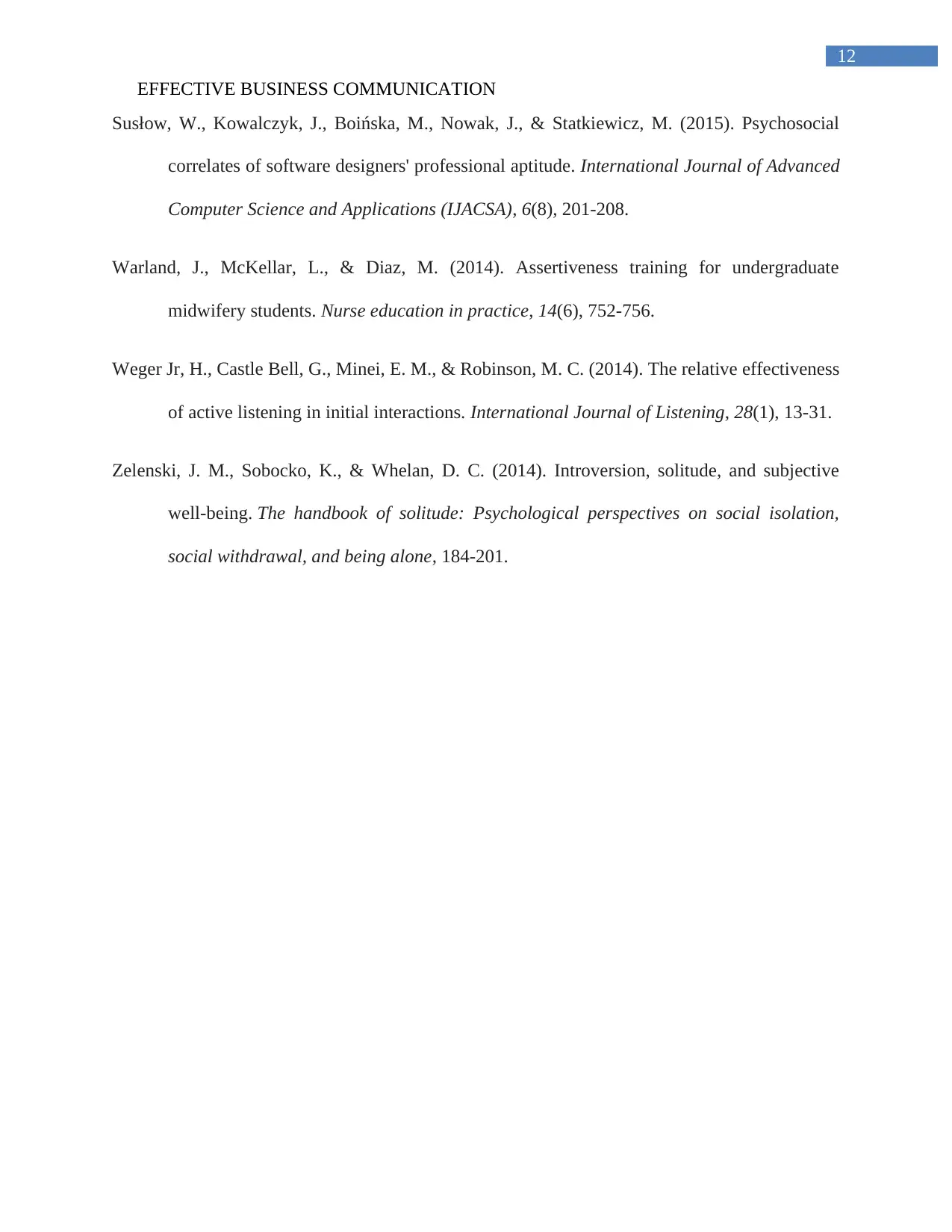
12
EFFECTIVE BUSINESS COMMUNICATION
Susłow, W., Kowalczyk, J., Boińska, M., Nowak, J., & Statkiewicz, M. (2015). Psychosocial
correlates of software designers' professional aptitude. International Journal of Advanced
Computer Science and Applications (IJACSA), 6(8), 201-208.
Warland, J., McKellar, L., & Diaz, M. (2014). Assertiveness training for undergraduate
midwifery students. Nurse education in practice, 14(6), 752-756.
Weger Jr, H., Castle Bell, G., Minei, E. M., & Robinson, M. C. (2014). The relative effectiveness
of active listening in initial interactions. International Journal of Listening, 28(1), 13-31.
Zelenski, J. M., Sobocko, K., & Whelan, D. C. (2014). Introversion, solitude, and subjective
well-being. The handbook of solitude: Psychological perspectives on social isolation,
social withdrawal, and being alone, 184-201.
EFFECTIVE BUSINESS COMMUNICATION
Susłow, W., Kowalczyk, J., Boińska, M., Nowak, J., & Statkiewicz, M. (2015). Psychosocial
correlates of software designers' professional aptitude. International Journal of Advanced
Computer Science and Applications (IJACSA), 6(8), 201-208.
Warland, J., McKellar, L., & Diaz, M. (2014). Assertiveness training for undergraduate
midwifery students. Nurse education in practice, 14(6), 752-756.
Weger Jr, H., Castle Bell, G., Minei, E. M., & Robinson, M. C. (2014). The relative effectiveness
of active listening in initial interactions. International Journal of Listening, 28(1), 13-31.
Zelenski, J. M., Sobocko, K., & Whelan, D. C. (2014). Introversion, solitude, and subjective
well-being. The handbook of solitude: Psychological perspectives on social isolation,
social withdrawal, and being alone, 184-201.
Paraphrase This Document
Need a fresh take? Get an instant paraphrase of this document with our AI Paraphraser

13
EFFECTIVE BUSINESS COMMUNICATION
Appendix 1: Big 5 Personality Test
EFFECTIVE BUSINESS COMMUNICATION
Appendix 1: Big 5 Personality Test
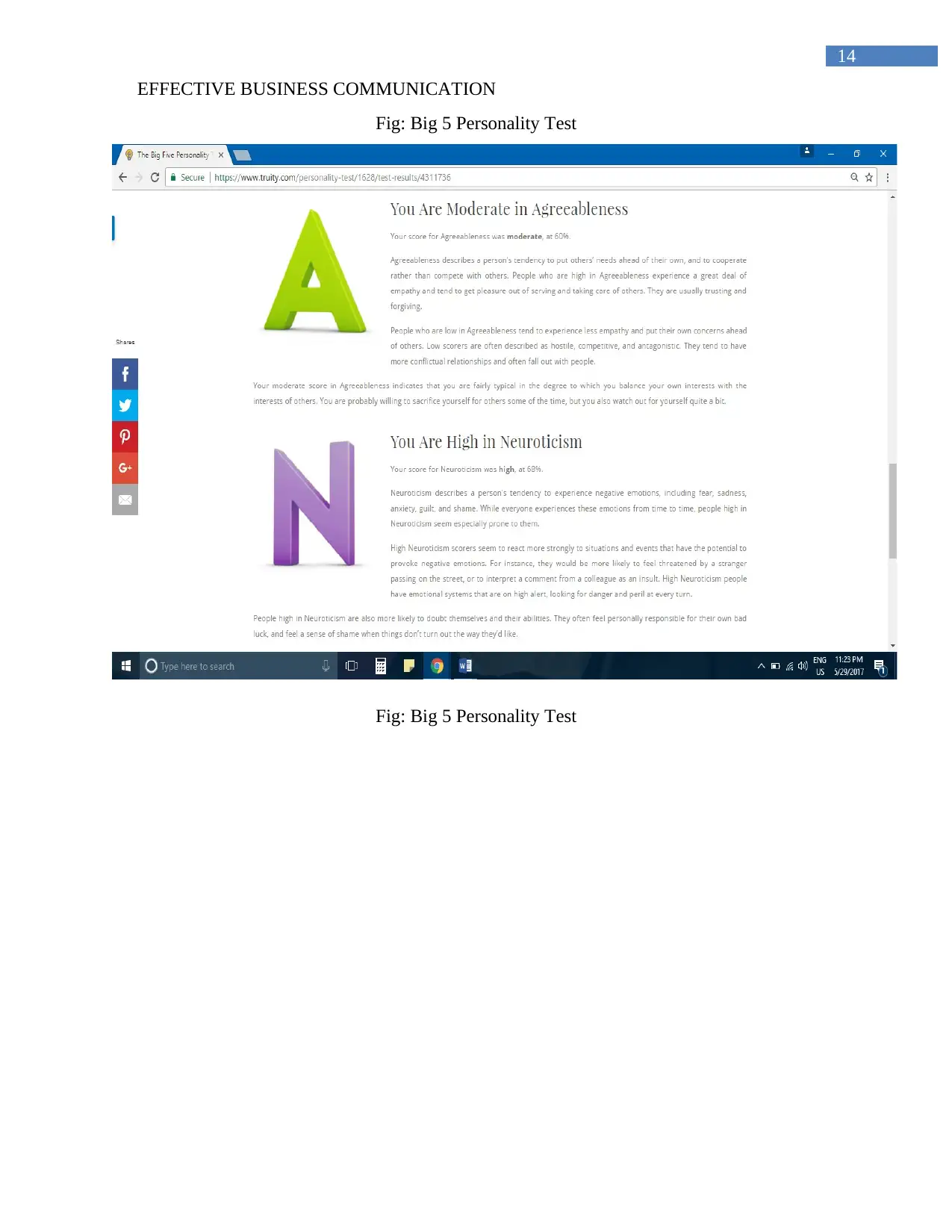
14
EFFECTIVE BUSINESS COMMUNICATION
Fig: Big 5 Personality Test
Fig: Big 5 Personality Test
EFFECTIVE BUSINESS COMMUNICATION
Fig: Big 5 Personality Test
Fig: Big 5 Personality Test
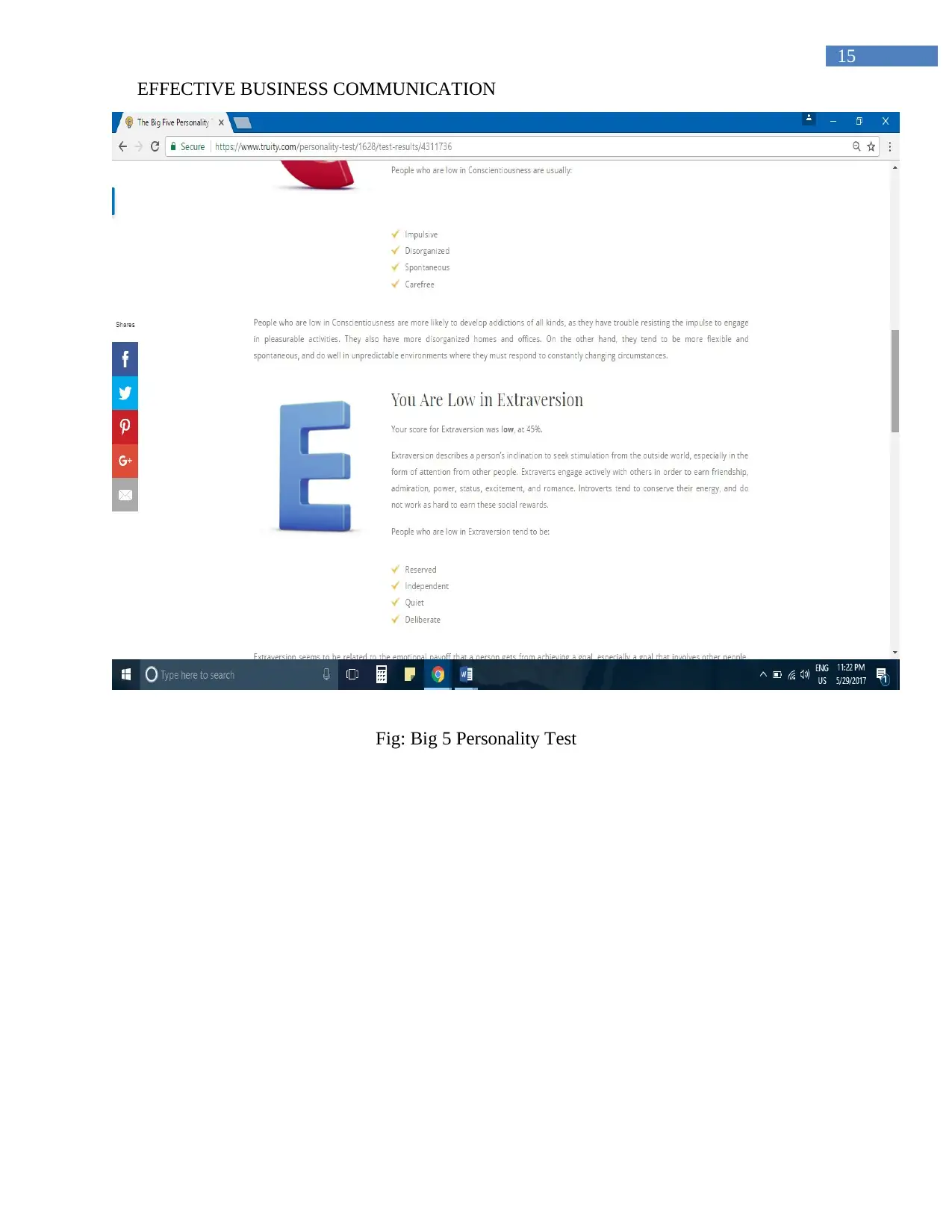
15
EFFECTIVE BUSINESS COMMUNICATION
Fig: Big 5 Personality Test
EFFECTIVE BUSINESS COMMUNICATION
Fig: Big 5 Personality Test
Secure Best Marks with AI Grader
Need help grading? Try our AI Grader for instant feedback on your assignments.
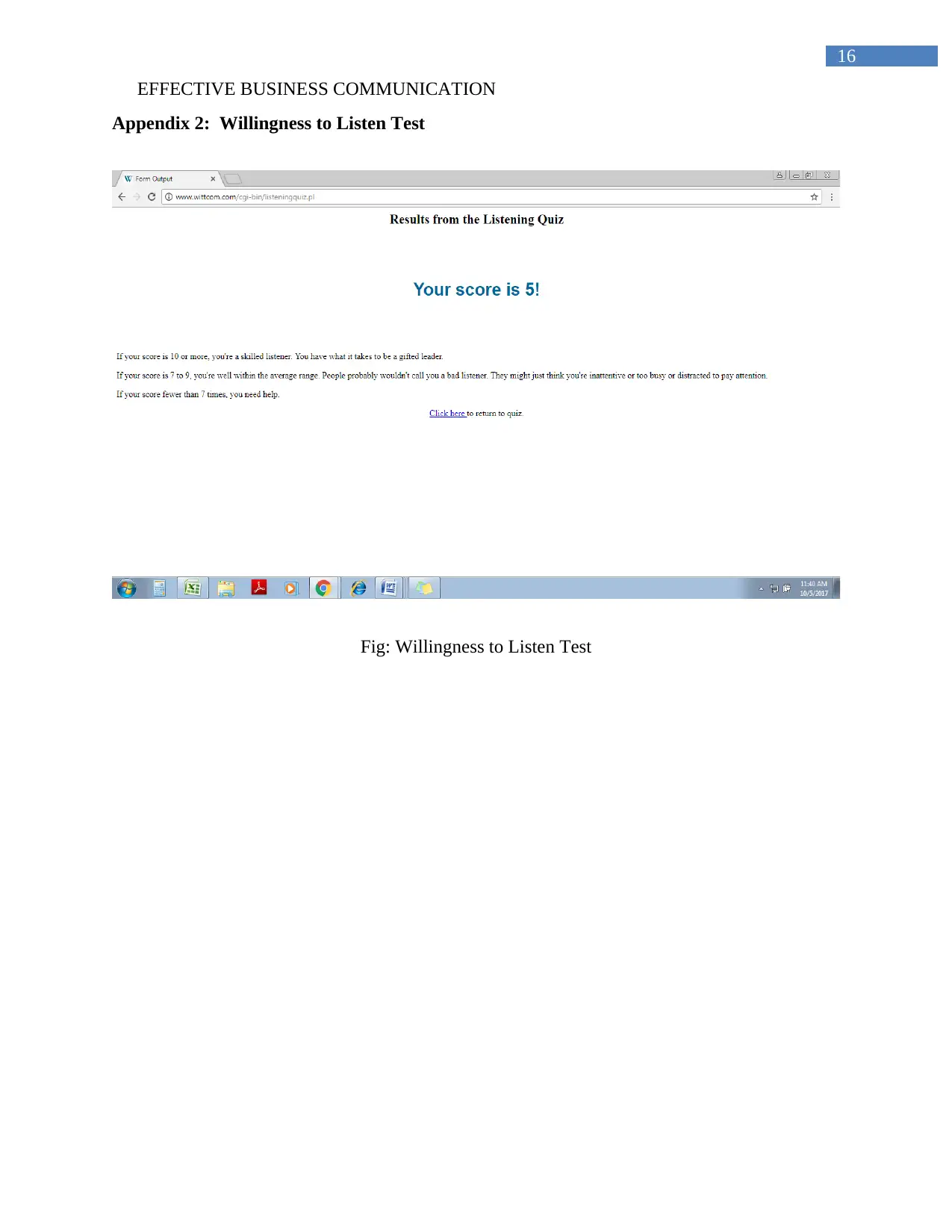
16
EFFECTIVE BUSINESS COMMUNICATION
Appendix 2: Willingness to Listen Test
Fig: Willingness to Listen Test
EFFECTIVE BUSINESS COMMUNICATION
Appendix 2: Willingness to Listen Test
Fig: Willingness to Listen Test
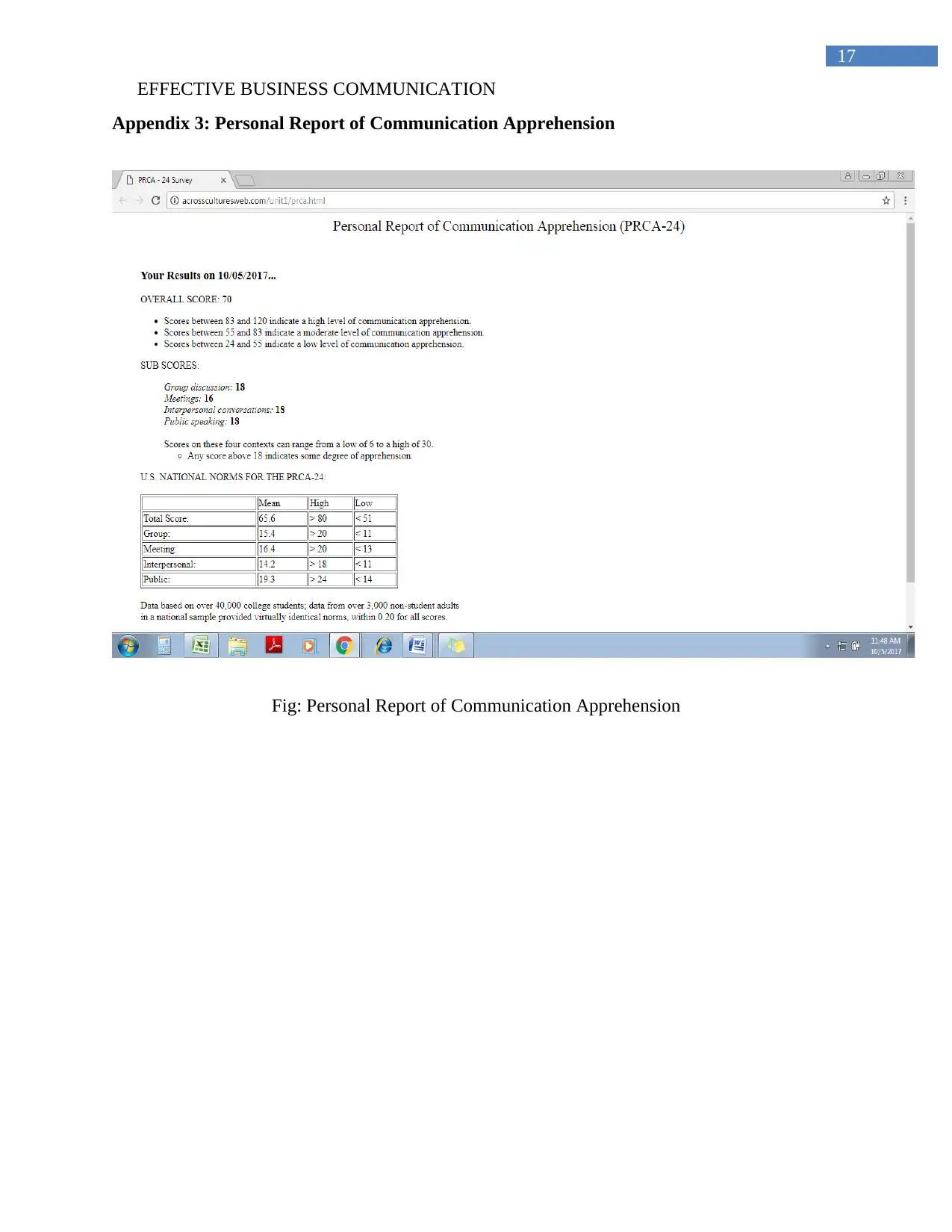
17
EFFECTIVE BUSINESS COMMUNICATION
Appendix 3: Personal Report of Communication Apprehension
Fig: Personal Report of Communication Apprehension
EFFECTIVE BUSINESS COMMUNICATION
Appendix 3: Personal Report of Communication Apprehension
Fig: Personal Report of Communication Apprehension
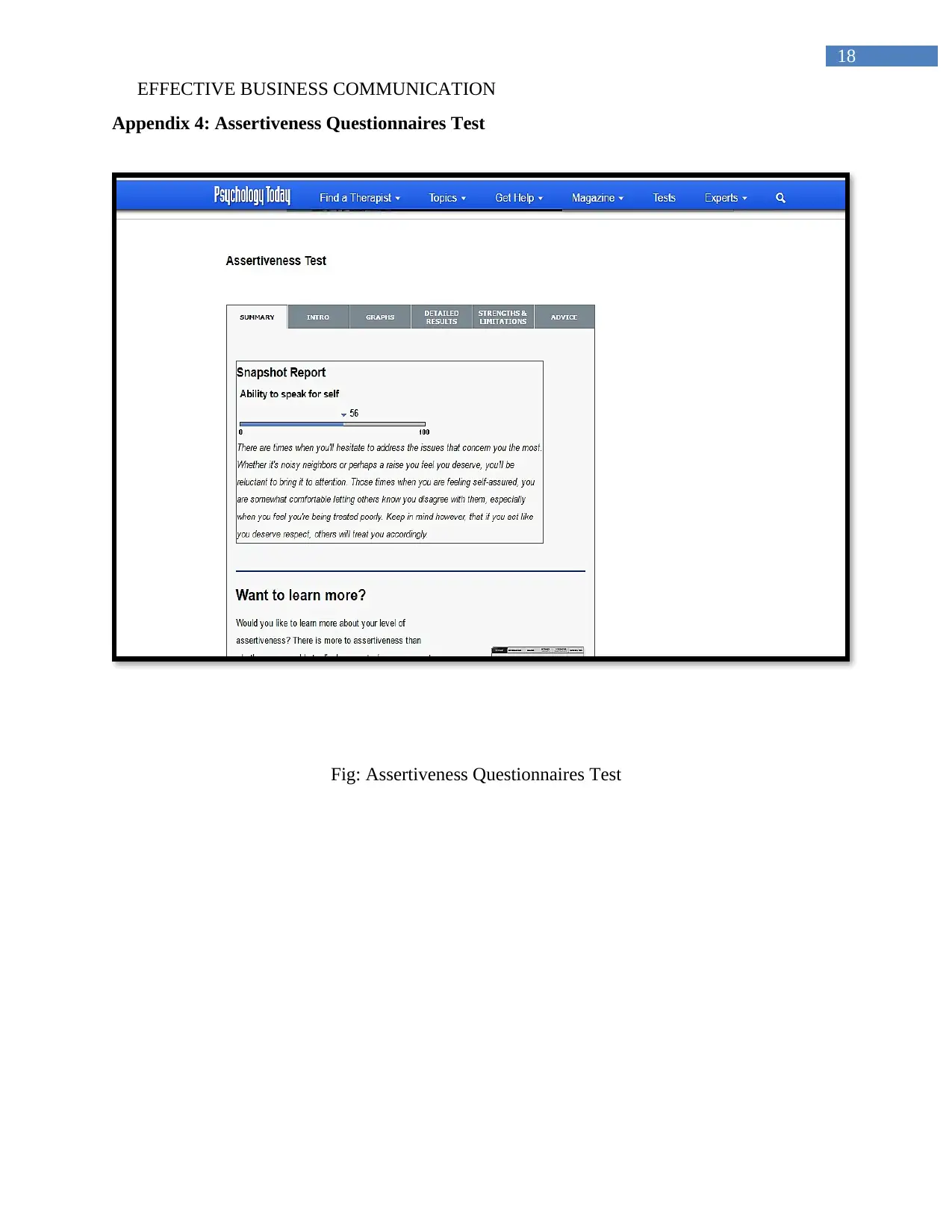
18
EFFECTIVE BUSINESS COMMUNICATION
Appendix 4: Assertiveness Questionnaires Test
Fig: Assertiveness Questionnaires Test
EFFECTIVE BUSINESS COMMUNICATION
Appendix 4: Assertiveness Questionnaires Test
Fig: Assertiveness Questionnaires Test
Paraphrase This Document
Need a fresh take? Get an instant paraphrase of this document with our AI Paraphraser

19
EFFECTIVE BUSINESS COMMUNICATION
Appendix 5: Johari Window
Fig: Johari Window
EFFECTIVE BUSINESS COMMUNICATION
Appendix 5: Johari Window
Fig: Johari Window
1 out of 20
Related Documents
Your All-in-One AI-Powered Toolkit for Academic Success.
+13062052269
info@desklib.com
Available 24*7 on WhatsApp / Email
![[object Object]](/_next/static/media/star-bottom.7253800d.svg)
Unlock your academic potential
© 2024 | Zucol Services PVT LTD | All rights reserved.





